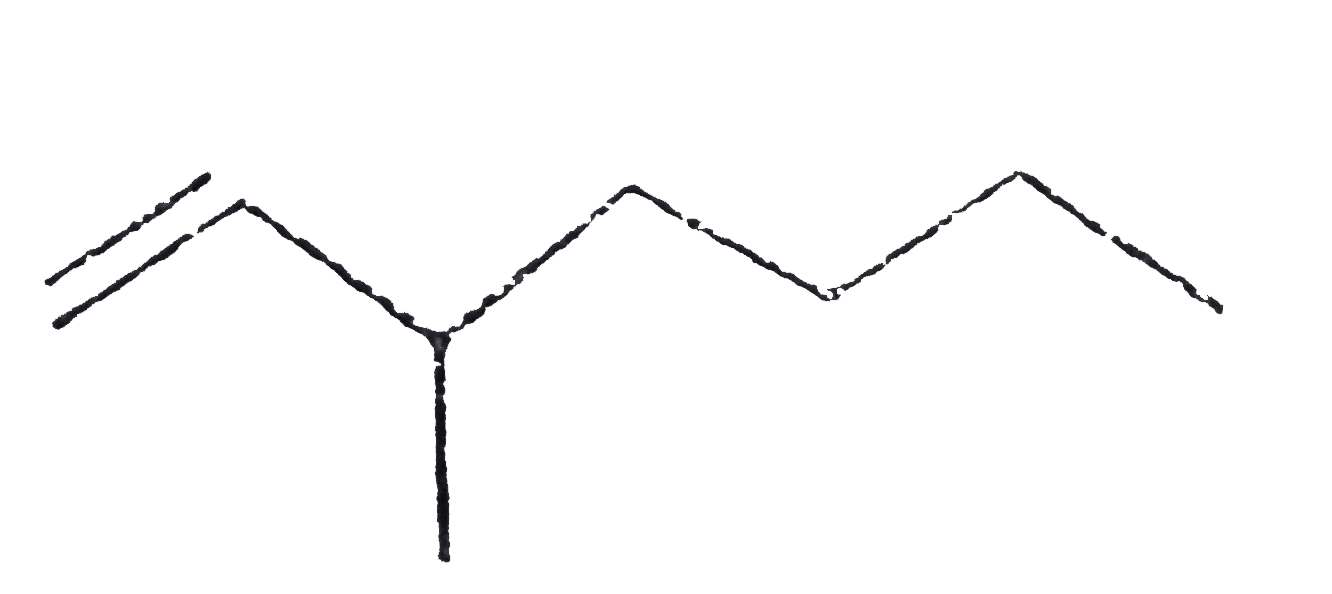Out of the given isomeric hydrocarbons which will undergoes rearrangement reaction in acidic medium?




The correct Answer is:B, C
To determine which isomeric hydrocarbons will undergo rearrangement reactions in acidic medium, we need to analyze the stability of the carbocations formed during the reaction. Here’s a step-by-step solution:
Step 1: Identify the Isomeric Hydrocarbons
Assume we have four isomeric alkenes (let's label them A, B, C, and D). Each of these alkenes will react with an acid (H+) to form a carbocation.
Step 2: Apply Markovnikov's Rule
According to Markovnikov's rule, when H+ adds to an alkene, it will attach to the carbon that has more hydrogen atoms already attached, leading to the formation of a more stable carbocation.
Step 3: Analyze Each Isomer
1. Isomer A:
- When H+ is added, it forms a tertiary carbocation (3°).
- Tertiary carbocations are stable and do not undergo rearrangement.
- Conclusion: No rearrangement.
2. Isomer B:
- This is a symmetrical alkene.
- H+ addition leads to a secondary carbocation (2°).
- A secondary carbocation can rearrange to form a more stable tertiary carbocation via a 1,2-hydride shift.
- Conclusion: Rearrangement is possible.
3. Isomer C:
- Upon addition of H+, a secondary carbocation is formed.
- Similar to Isomer B, this secondary carbocation can rearrange to a more stable tertiary carbocation.
- Conclusion: Rearrangement is possible.
4. Isomer D:
- H+ addition forms a tertiary carbocation (3°).
- Since it is already stable, it will not undergo rearrangement.
- Conclusion: No rearrangement.
Step 4: Final Conclusion
Based on the analysis:
- Isomers B and C can undergo rearrangement reactions in acidic medium.
- Isomers A and D do not undergo rearrangement.
Summary
The isomeric hydrocarbons that will undergo rearrangement reactions in acidic medium are Isomer B and Isomer C.
Assume we have four isomeric alkenes (let's label them A, B, C, and D). Each of these alkenes will react with an acid (H+) to form a carbocation.
According to Markovnikov's rule, when H+ adds to an alkene, it will attach to the carbon that has more hydrogen atoms already attached, leading to the formation of a more stable carbocation.
1. Isomer A:
- When H+ is added, it forms a tertiary carbocation (3°).
- Tertiary carbocations are stable and do not undergo rearrangement.
- Conclusion: No rearrangement.
- This is a symmetrical alkene.
- H+ addition leads to a secondary carbocation (2°).
- A secondary carbocation can rearrange to form a more stable tertiary carbocation via a 1,2-hydride shift.
- Conclusion: Rearrangement is possible.
- Upon addition of H+, a secondary carbocation is formed.
- Similar to Isomer B, this secondary carbocation can rearrange to a more stable tertiary carbocation.
- Conclusion: Rearrangement is possible.
- H+ addition forms a tertiary carbocation (3°).
- Since it is already stable, it will not undergo rearrangement.
- Conclusion: No rearrangement.
Based on the analysis:
- Isomers B and C can undergo rearrangement reactions in acidic medium.
- Isomers A and D do not undergo rearrangement.
The isomeric hydrocarbons that will undergo rearrangement reactions in acidic medium are Isomer B and Isomer C.
Topper's Solved these Questions
- ORGANIC CHEMISTRY: SOME BASIC PRINCIPLE AND TECHNIQUESBOOK - AAKASH INSTITUTE ENGLISHCHAPTER - ORGANIC CHEMISTRY: SOME BASIC PRINCIPLE AND TECHNIQUESEXERCISE - SECTION-D LINKED COMPREHENSION TYPE QUESTIONS
7 Videos
- ORGANIC CHEMISTRY: SOME BASIC PRINCIPLE AND TECHNIQUESBOOK - AAKASH INSTITUTE ENGLISHCHAPTER - ORGANIC CHEMISTRY: SOME BASIC PRINCIPLE AND TECHNIQUESEXERCISE - SECTION-E ASSERTION-REASON TYPE QUESTIONS
14 Videos
- ORGANIC CHEMISTRY: SOME BASIC PRINCIPLE AND TECHNIQUESBOOK - AAKASH INSTITUTE ENGLISHCHAPTER - ORGANIC CHEMISTRY: SOME BASIC PRINCIPLE AND TECHNIQUESEXERCISE - SECTION-B OBJECTIVE TYPE QUESTION (ONE OPTION IS CORRECT)
37 Videos
- ORGANIC CHEMISTRY : SOME BASIC PRINCIPLES AND TECHNIQUES BOOK - AAKASH INSTITUTE ENGLISHCHAPTER - ORGANIC CHEMISTRY : SOME BASIC PRINCIPLES AND TECHNIQUES EXERCISE - Assignment(Section-D)(Assertion - Reason Type Questions)
15 Videos
- POLYMERSBOOK - AAKASH INSTITUTE ENGLISHCHAPTER - POLYMERSEXERCISE - ASSIGNMENT (SECTION-D)
13 Videos
Similar Questions
Knowledge Check
Which of the following isomeric hydrocarbons is most acidic ?
A B
B C
C D
D
Which of the following isomeric hydrocarbon is most acidic ?
A B
B C
C D
D
The compound which undergoes Srl reaction most rapidly is :
A B
B C
C D
D
Which of the following is not a rearrangement reaction ?
View SolutionWhich of the following is stronger hydrocarbon acid ?
View SolutionWhich will undergo reaction with ammonical AgNO3 :
View SolutionWhich of the following carbocation can not undergo rearrangement ?
View SolutionWhich of the following alkenes does not undergo rearrangement on heating with a strong acid?
View Solution
